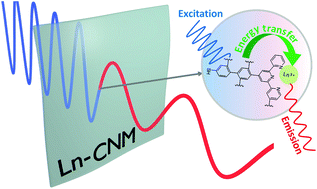Photoactive ultrathin molecular nanosheets with reversible lanthanide binding terpyridine centers†
Abstract
In recent years, functional molecular nanosheets have attracted much attention in the fields of sensors and energy storage. Here, we present an approach for the synthesis of photoactive metal–organic nanosheets with ultimate molecular thickness. To this end, we apply low-energy electron irradiation induced cross-linking of 4′-(2,2′:6′,2′′-terpyridine-4′-yl)-1,1′-biphenyl-4-thiol self-assembled monolayers on gold to convert them into functional ∼1 nm thick carbon nanomembranes possessing the ability to reversibly complex lanthanide ions (Ln-CNMs). The obtained Ln-CNMs can be prepared on a large-scale (>10 cm2) and inherit the photoactivity of the pristine terpyridine lanthanide complex (Ln(III)-tpy). Moreover, they possess mechanical stability as free-standing sheets over micrometer sized openings. The presented methodology paves a simple and robust way for the preparation of ultrathin nanosheets with tailored photoactive properties for application in photocatalytic and energy conversion devices.



 Please wait while we load your content...
Please wait while we load your content...